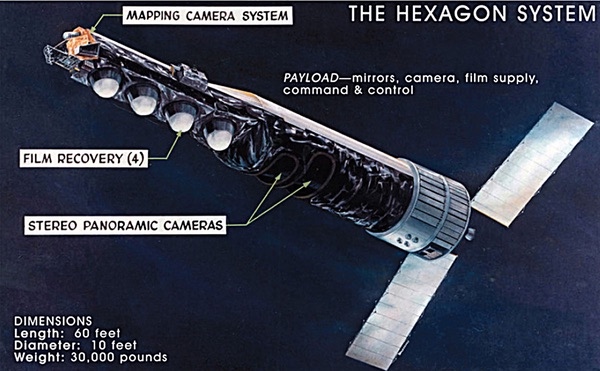Roads not taken in satellite photo-reconnaissance: Part 2, the 1970sby Dwayne A. Day
|
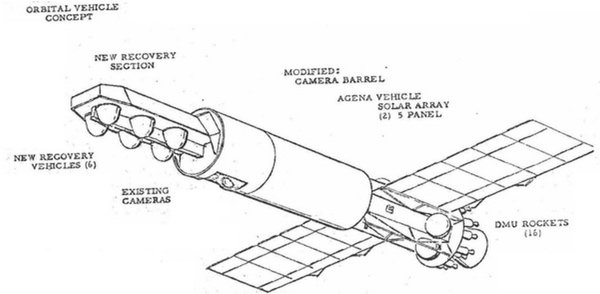 In the early 1970s, the National Reconnaissance Office evaluated multiple options to return imagery faster. One proposal was to modify the proven CORONA reconnaissance satellite and replace its two larger film reentry vehicles with six smaller ones that could be returned to Earth quickly. The satellite also would have been equipped with solar panels for longer operation than the standard CORONA. (credit: NRO) |
CORONA 6-Pack
Years: 1970–1971
Details: CORONA J-3 (KH-4B) equivalent, two panoramic cameras
According to Joe Page II, the CORONA 6-Pack was proposed as a relatively minimal modification to the existing KH-4B CORONA reconnaissance satellite. The 6-Pack would retain the J-3 camera system, but replace the two Mark V reentry vehicles with six smaller vehicles mounted to a new spacecraft forebody. The satellite would also be equipped with two solar panels to provide power to the spacecraft, whereas the CORONA was run on batteries. An alternative configuration replaced the two 61-centimeter (24-inch) panoramic cameras with two 19-centimeter (36-inch) panoramic cameras to increase the ground resolution (see “National Reconnaissance Program crisis photography concepts, part 1: A six-pack of Corona,” The Space Review, May 31, 2022);
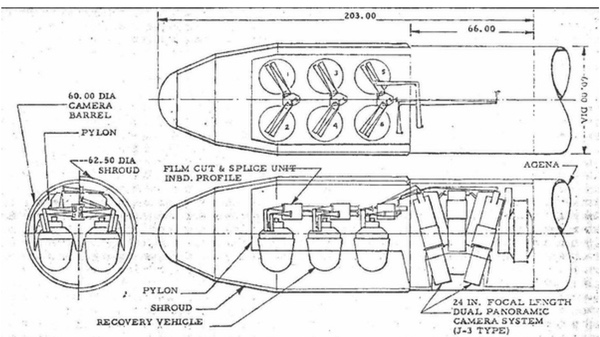 By the early 1970s, CORONA had flown dozens of missions and the panoramic camera system was well-proven. The CORONA Six-Pack proposal would have used the standard camera but substituted six reentry vehicles instead of the normal two. The downside was that CORONA had lower resolution than desired for many crisis situations. (credit: NRO) |
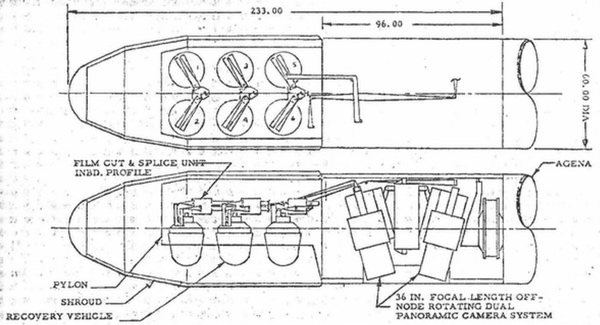 An alternative proposal would have increased the focal length of the two CORONA cameras to improve the ground resolution. This would have required more development. (credit: NRO) |
GAMBIT 6-Pack
Years: 1970–1971
Details: GAMBIT-3 equivalent camera
There is no information available about the GAMBIT 6-Pack other than its name. Presumably it would have adopted the same approach as the CORONA 6-Pack, using the standard GAMBIT-3 camera then in service but replacing the two Mark V reentry vehicles with six smaller reentry vehicles. Five of the reentry vehicles would return film from the prime camera, and the sixth would return the Astro Position Terrain Camera film and the tape recorder. The GAMBIT 6-Pack, like the CORONA 6-Pack, apparently was not considered an attractive option for the crisis response satellite because neither were included in an array of possible options that were evaluated in April 1971.
GAMBIT 3-Pack
Years: 1970–1971
Details: GAMBIT-3 equivalent camera
This was a variant of the GAMBIT 6-Pack vehicle, but with three Mark V reentry vehicles rather than the standard two Mark V reentry vehicles or the proposed six smaller reentry vehicles. The vehicle would still use the same Titan launch vehicle, but the higher mass would result in a lower inclination orbit than the standard GAMBIT-3 (but still higher inclination than the heavier GAMBIT 6-Pack). The expected program would be six missions per year, providing 18 reentry vehicles per year. Somewhat ironically, this would cost more than launching nine GAMBIT-3 missions also with a total of 18 reentry vehicles, because the higher production rate would result in a lower unit cost.
One document refers to a GAMBIT system known as “Multi-Boy,” apparently a shorthand reference to either the three or six-pack versions. (Around the same time, the NRO was developing the capability to operate GAMBIT in a much higher orbit, under the codename HIGHER BOY, sometimes referred to as HIGHERBOY or HIGH BOY.)
HEXAGON Variant
Years: 1970–1971
Details: HEXAGON satellite equipped with three standard reentry vehicles and eight Mark V reentry vehicles
Twelve of the 19 HEXAGON missions flown between 1971 and 1984 carried four large reentry vehicles and a HEXAGON Mapping Camera equipped with a Mark V reentry vehicle of the same type used for the CORONA and GAMBIT programs. The HEXAGON Variant considered for the crisis response mission would have replaced one of the large reentry vehicles with a module containing eight Mark V reentry vehicles and extending the mission lifetime to approximately 120 days. One mission profile would have had the HEXAGON collecting against the standing search mission requirements for the first 30 days and using the three main reentry vehicles. The next 90 days of the mission would be spent in “crisis response mode” with the eight smaller reentry vehicles available for rapid data return. With four HEXAGON missions per year, this could provide 120 days of normal collection and 360 days of potential crisis response. Two other options included a modification to provide for transfer of film between main and crisis reentry vehicles on command, and the replacement of the four large reentry vehicles with sixteen Mark V reentry vehicles. These later variants were not costed.
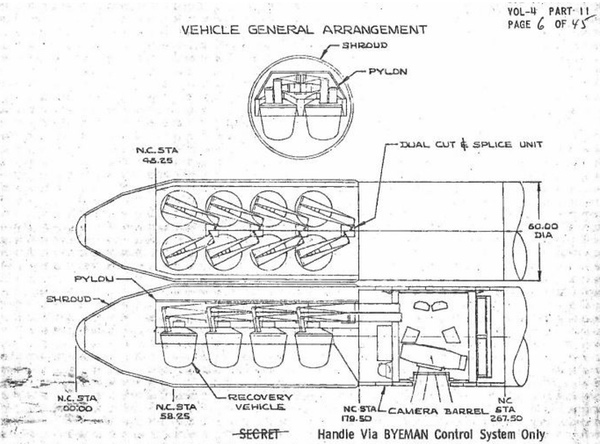 The PINTO system was named after the inexpensive car (before it became notorious for exploding). PINTO would have used a powerful camera derived from an aerial reconnaissance system. It would have been equivalent to the HEXAGON in terms of resolution, but covered much less area. (credit: NRO) |
PINTO
Year: 1971
Focal length: 122 centimeters (48 inches)
Ground resolution: 61–91 centimeters (2–3 feet)
Details: single panoramic camera
According to Joe Page II, in 1971 a team proposed the PINTO satellite concept using a powerful camera developed for aerial reconnaissance and integrated with a new satellite forebody carrying eight reentry vehicles, each of them two-thirds the size of the Mark V version then in use on the CORONA and GAMBIT satellites. The camera system would have been a modified version of the Fairchild Camera and Instrument Corporation’s KA-81 Long Focal Length Panoramic Reconnaissance Camera, then used for the secretive BIG SAFARI aerial reconnaissance program. According to the proposal, “PINTO has resolution as good as HEXAGON [i.e. 61 to 91 centimeters], but its capacity is much smaller,” adding that “rapid response and low cost make it an ideal junior partner for HEXAGON.”
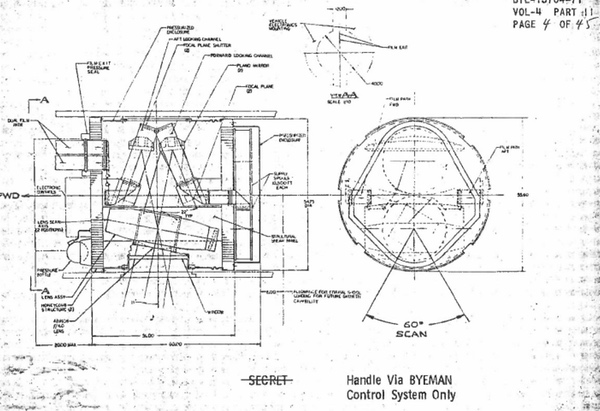 The PINTO system was named after the inexpensive car (before it became notorious for exploding). PINTO would have used a powerful camera derived from an aerial reconnaissance system. It would have been equivalent to the HEXAGON in terms of resolution, but covered much less area. (credit: NRO) |
The proposal evaluated the possibility of Atlantic Ocean recovery to return film faster to photo-interpreters. This would have required basing a fleet of seven recovery aircraft on the U.S. East Coast. However, the Atlantic recovery would not have appreciably shortened the time to deliver photographs to interpreters compared to recovery northwest of Hawaii and interpretation in Honolulu, and would have had a high cost.
PINTO apparently was named for the inexpensive Ford Pinto automobile. At the time of the study, the Pinto had not yet achieved notoriety for bursting into flames after relatively minor rear-end collisions (see “National Reconnaissance Program crisis photography concepts, part 2: PINTO,” The Space Review, February 6, 2023).
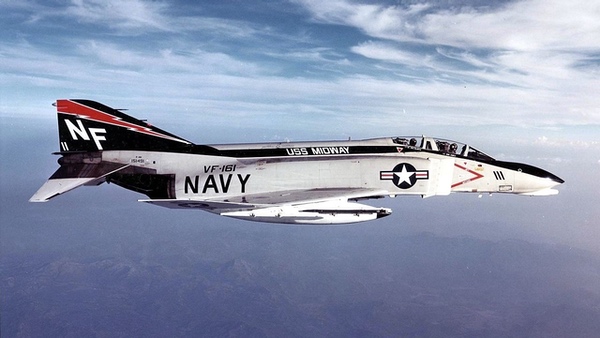 The AXUMITE proposal was to launch a reconnaissance satellite atop a rocket carried by an F-4 Phantom. (credit: US Navy) |
AXUMITE
Years: 1970–1971
Focal length: 46 centimeters (18 inches)
Ground resolution: 150-210 centimeters (5–7 feet)
Details: panoramic camera, probably CORONA-derived
Air-launching of reconnaissance satellites had been proposed throughout the 1960s, usually from high-speed aircraft like the A-12 and B-58. During the crisis response satellite studies, one contractor proposed air-launching a rocket from underneath an F-4 Phantom interceptor.
A variety of cameras were possible, although the most logical appeared to be a variant of the type of camera system successfully used in the CORONA reconnaissance satellite with a Petzval lens system rotating to create a panoramic image. The CORONA had a 61-centimeter (24-inch) focal length, and the AXUMITE would have had a 46-centimeter (18-inch) focal length. The camera had to fit into an 84-centimeter (33-inch) diameter, 36-centimeter (14-inch) deep space on the vehicle. With the spacecraft entering a low, circular orbit capable of surviving for at least six revolutions, the coverage could be obtained on the first, second, or third revolution after launch. The goal was 150–210 centimeters resolution (5–7 feet).
The rocket would have consisted of four stages plus strap-ons. The first three stages plus strap-ons would be solid propellant, with the first stage developed from the Skybolt missile. Launch would have taken place from Hawaii, Johnston Island, Wake Island, Guam, or Okinawa. The entire Eurasian continent could be accessed, and recovery would have been by surface pick-up. In the Pacific this would happen in darkness.
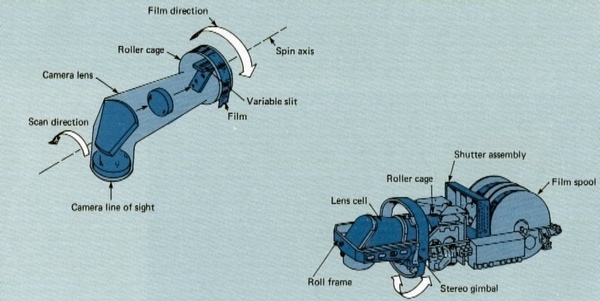 The first iteration of FASTBACK involved using a film camera with an optical bar design providing panoramic photos. Itek had already built the KA-80 optical bar camera used in the U-2 and SR-71 aircraft and adapted for Apollo. The second iteration of FASTBACK would have developed the film in orbit, scanned it, and beamed the images back to Earth. (credit: USAF) |
FASTBACK
Years: 1970–1971
Focal length: 69 centimeters (27 inches) and 61 centimeters (24 inches) variants/FASTBACK B: 114 centimeters (45-inches)
Ground resolution: 100 centimeters (3.3 feet)/FASTBACK B: 84 centimeters (2.1 feet)
Details: film-return and film-readout variants
The FASTBACK (sometimes spelled “FAST BACK”) was a proposal to carry a camera system atop a Minuteman I missile modified to place a small payload in orbit, launching it from Johnston Atoll in the Pacific Ocean. The proposal was initiated by a retired Air Force general and studied by Martin Marietta. FASTBACK went through two iterations: film-return and film-scanning.
In November 1970, Martin Marietta proposed a satellite vehicle with a 100-centimeter (3.3-foot) ground resolution. Three different cameras were possible, manufactured by Fairchild, Hycon, and Itek, with the Fairchild camera having a 69-centimeter (27-inch) focal length and the others 61-centimeter (24-inch) focal lengths. All three would be panoramic optical bar designs. Itek had already developed an aerial optical bar camera that was adapted to fly on the Apollo 15, 16, and 17 missions.
The vehicle would be launched from Johnston Island in the Pacific Ocean and recovered by aerial catch over the Atlantic Ocean, the same technique then used for film-return satellites such as CORONA and GAMBIT. If the vehicle was recovered over the Pacific, this would add 13 hours to the recovery time. In the company’s proposal, for a case study they referenced a recent aircraft hijacking in the Middle East and a photographic pass over the airfield to return photos to Washington within the critical 24-hour time period.
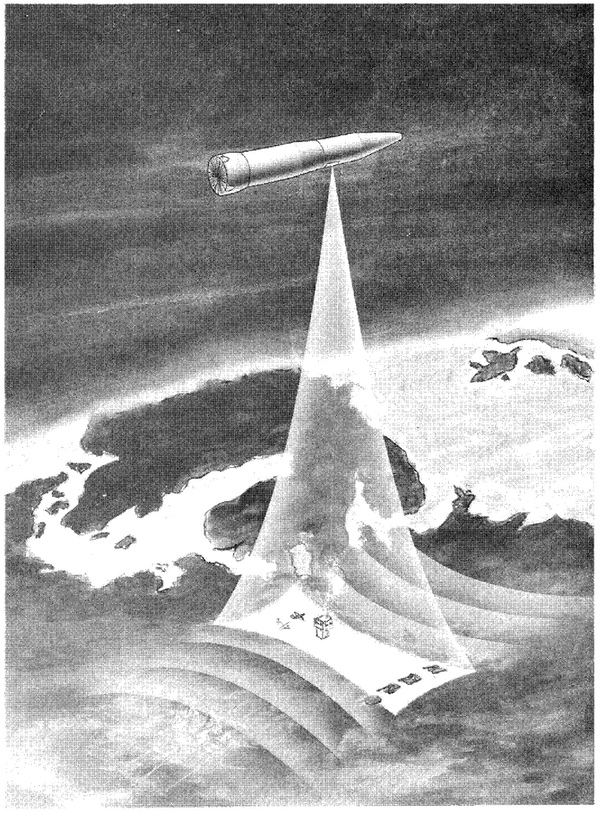 The FASTBACK proposal involved launching a Minuteman I missile from Johnston Island in the Pacific so that it would fly a short mission carrying a panoramic camera. (credit: NRO) |
By April 1971, Martin Marietta submitted a revised proposal named “FASTBACK B.” It also would have used a modified Minuteman I rocket. Instead of returning its film to Earth, it would have included a readout option whereby imagery was transmitted to a ground station. The satellite could have stayed in orbit for 30 days. The camera would have had a 114-centimeter (45-inch) focal length and used the spinning vehicle to take a panoramic image of the ground below. The film would have been processed onboard the spacecraft before being scanned and transmitted. The resolution would have been essentially equivalent to the film return version.
Another option was evaluated in April 1971 using a panoramic optical bar camera designed by the Perkin-Elmer Corporation. This version would have been capable of 84-centimeter (2.1-foot) ground resolution. It would have carried 2,377 meters (7,800 feet) of 13-centimeter (5-inch) wide film weighing 21 kilograms (46 pounds). This option may have been requested by the NRO rather than part of Martin Marietta’s initial proposal.
For Johnston Island launches, FASTBACK would have used facilities built for the Program 437 anti-satellite weapon. By the early 1970s, Program 437 was expected to be canceled or mothballed, making the buildings and launch pad available for other projects. The film vehicles had some similarities to a mid-1960s project named Program 437AP. Program 437AP used the launch vehicle and spacecraft of Program 437, but instead of a nuclear warhead it was equipped with a modified CORONA panoramic camera and a reentry vehicle. It used the camera to photograph another spacecraft in flight. Only one 437AP test mission was flown, apparently successfully, but the program was soon discontinued.
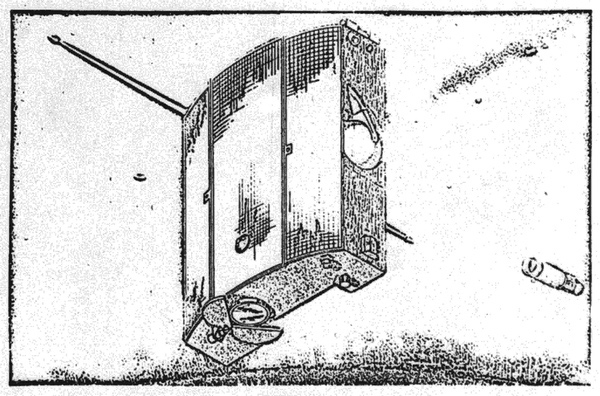 When first proposed in 1967, SPIN SCAN was to be deployed off of a much larger HEXAGON spacecraft. Over the years, the SPIN SCAN design got bigger and heavier in order to meet mission requirements, and by 1971 the concept was to launch a single satellite atop an Atlas F rocket on ready alert at Vandenberg Air Force Base in California. (credit: NRO) |
SPIN SCAN
Years: 1967–1969/1970–1971
204-kilogram (450-pound) vehicle
Focal length: 61 centimeters (24 inches) (estimate)
Ground resolution: 180–300 centimeters (6–10 feet)
Details: carried on HEXAGON
272-kilogram (600-pound) vehicle
Focal length: 91 centimeters (36 inches)
Ground resolution: 131–159 centimeters (4.3–5.2 feet)
Details: carried on HEXAGON
396-kilogram (875-pound) vehicle
Focal length: 91 centimeters (36 inches)
Ground resolution: 131–159 centimeters (4.3–5.2 feet)
Details: carried on HEXAGON
544-kilogram (1,200-pound) vehicle
Focal length: 127 centimeters (50 inches)
Ground resolution: 88–107 centimeters (2.9–3.5 feet)
Details: carried on HEXAGON
726-kilogram (1,600-pound) vehicle
Focal length: 152 centimeters (60 inches)
Ground resolution: 76–91 centimeters (2.5–3 feet)
Details: carried on Atlas F
SPIN SCAN was the most important of the crisis response satellite studies and was apparently considered the front runner and close to approval in spring 1971. Contractors evaluated multiple variants of SPIN SCAN with different masses and capable of being deployed as a secondary satellite off other launches, or as a dedicated launch atop an Atlas rocket.
The RAND Corporation’s Merton Davies was one of the first people to study satellite reconnaissance. Along with Amrom Katz, in 1956 he proposed the film-return satellite that became the CORONA program, which first entered service in 1960. Even though satellite reconnaissance was highly classified during the 1960s, Davies was still able to publish articles about Earth observation, proposing innovative methods of using satellites for low-resolution mapping and other observation missions. In October 1966, Davies wrote a paper for RAND and a year later published an article proposing a satellite for arms control monitoring that would use the film scanning technology first developed for the Samos E-1 and E-2 programs. Despite Davies proposing the concept, it appears that when SPIN SCAN was formally studied for development starting in 1967, Davies’ proposal was overlooked.
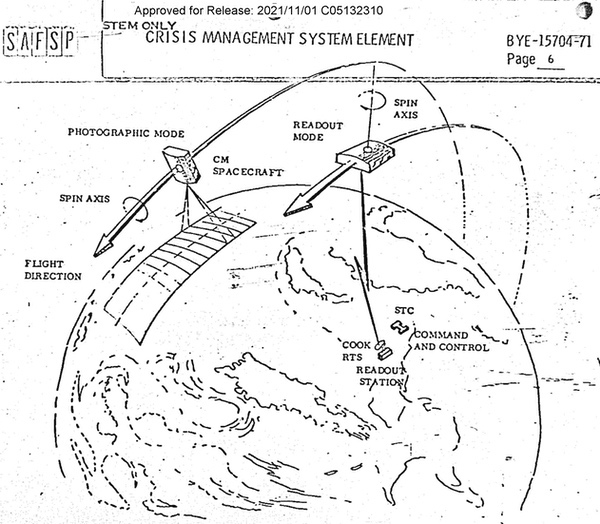 SPIN SCAN was a proposal studied by multiple companies in the late 1960s and early 1970s. It would have processed and scanned exposed film in orbit and transmitted the imagery to the ground, preferably in less than 12 hours. SPIN SCAN was almost approved for development in 1971. (credit: NRO) |
The NRO study of a SPIN SCAN satellite started in 1967 in response to several events. The HEXAGON area search reconnaissance satellite was then in development to replace the CORONA satellite. Whereas CORONA satellites were launched on an almost monthly basis, HEXAGON would have a much lower launch rate of four missions per year. CORONA satellites were also held in a launch readiness state, making it possible to launch within a few weeks’ notice (shorter if a satellite was placed on ready-alert). With CORONA scheduled for retirement, some members of the reconnaissance community believed there was a need for a satellite that could provide faster response time and fill in the gaps created by a late HEXAGON mission. In addition, the Soviet Union was developing a non-nuclear ASAT weapon, which some feared could be used against American satellites. Two SPIN SCAN satellites could be carried into orbit on a HEXAGON satellite and deployed, therefore ensuring that the United States had three photo-reconnaissance satellites in orbit. The SPIN SCAN satellites could be dormant for months (possibly up to a year) and activated to provide crisis reconnaissance if necessary.
The first iteration of SPIN SCAN was a simple satellite weighing 204 kilograms (450 pounds), operating in a 277-kilometer (150-nautical-mile) orbit, and providing resolution of 1.8–3 meters (6–10 feet). SPIN SCAN eventually evolved into a more complicated and heavier satellite. Instead of being deployed from a HEXAGON, it would most likely be launched atop an Atlas F rocket, possibly in a cluster of four at a time.
Although the initial concept was for a satellite weighing 204 kilograms (450 pounds), this grew to 272 kilograms (600 pounds), and soon grew to 396 kilograms (875 pounds) as the design was refined. HEXAGON-deployed versions massing 396 and 544 kilograms (1,200 pounds) were considered. The final design would have used an Atlas F and weighed 726 kilograms (1,600 pounds). It was selected over the lighter versions based on image quality, coverage, and ability to select the desired orbital inclination. It would have been capable of operating in a 167-by-389-kilometer (90-by-210-nautical-mile) orbit for a month or more, providing a ground resolution of 76–91 centimeters (2.5–3 feet). However, as late as April 1971 there was still some interest from a senior intelligence advisor in a lighter-weight version that could be deployed from the HEXAGON. The lighter-weight versions would have had shorter focal lengths, lower resolution, and shorter lifetimes.
The satellite would have been a flat rectangle spin-stabilized at 29 rpm, with a panoramic camera mounted normal to the spin axis. During photography, the spin axis would be parallel to the Earth’s surface, providing an access swath of 333 kilometers (180 nautical miles). After passage over the “crisis area,” the spin axis would be pointed toward the sun to provide maximum exposure of solar cells on the broad side of the satellite and reduce drag by orienting the satellite to fly “edge-on” at perigee when no photography would be taken. Exposed film would be processed on board using the “bimat” process developed for Samos, and then the processed film would be scanned by a laser scanner and the video transmitted to the tracking station where the pictures would be reconstructed with a laser recorder.
Unlike most of the other proposals on this list, SPIN SCAN was extensively studied in the late 1960s, with at least four contractor studies performed in 1969. SPIN SCAN was also pushed by the NRO’s Los Angeles program office, known as the Secretary of the Air Force Special Projects office (also known as the NRO’s Program A). This was at a time when the CIA component of the NRO (Program B) in Washington was advocating development of an advanced and highly capable near-real time reconnaissance satellite. The CIA undoubtedly did not look favorably upon such a limited system as SPIN SCAN, even if it was only intended to serve until the new system, eventually named the KH-11 KENNEN, became operational in the latter 1970s. (See “Spinning towards the future: crisis response from space,” The Space Review, July 3, 2023, and “Crisis in space: The 1973 Yom Kippur War and ‘crisis reconnaissance’,” The Space Review, October 2, 2023.)
Very High Resolution (VHR) Satellite/Ultra High Resolution (UHR) Satellite
Years: 1969–1973
Focal length: MOL DORIAN equivalent
Ground resolution: 10 centimeters (4 inches)
In summer 1969, President Nixon canceled the Manned Orbiting Laboratory (MOL) program and its powerful DORIAN camera system. DORIAN was designed to have resolution of objects as small as 10 centimeters (4 inches) on the ground at a time when the best robotic system, the GAMBIT-3, had resolution of around 30 centimeters (12 inches). DORIAN was therefore a “very high resolution” system, and once it was canceled, some within the intelligence community began considering new systems that could achieve this high resolution. Details on this effort are still sparse, but it appears that at least one option, known as “HEXADOR,” was considered.
HEXADOR
Years: 1970–1973
Focal length: MOL DORIAN equivalent
Ground resolution: 10 centimeters (4 inches)
HEXADOR was a studied satellite that would have consisted of a DORIAN optical system and the forebody of a HEXAGON reconnaissance satellite with its four reentry vehicles. Few details are available on the HEXADOR proposal.
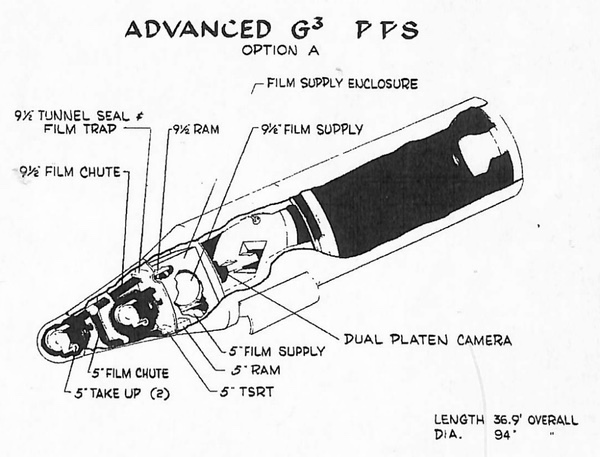 An alternative proposal would have increased the focal length of the two CORONA cameras to improve the ground resolution. This would have required more development. (credit: NRO) |
Advanced GAMBIT-3
Year: 1973
Focal length: MOL DORIAN equivalent
Ground resolution: 10 centimeters (4 inches), or better
The Advanced GAMBIT-3 was a study performed in 1973 of a very high-resolution film-return system based upon GAMBIT-3 and Manned Orbiting Laboratory technology. The GAMBIT-3 (also known as the KH-8) was then in service as a high-resolution film-return system. As Phil Horzempa has documented, the proposal was to conduct the first mission by mid-1978.
The origins of the 1973 study are unknown. However, in 1971 NRO was evaluating the possibility of an Ultra High Resolution version of GAMBIT with a 228-centimeter (90-inch) diameter mirror. By 1973, the KH-11 KENNEN electro-optical system was scheduled to enter service by late 1976, and the GAMBIT-3 was planned to continue in service until the early 1980s. KENNEN’s resolution was limited, and the Advanced GAMBIT-3 may have been a proposal to provide the kind of very high-resolution imagery that KENNEN could not. KENNEN was also under development by the CIA (NRO’s “Program B”) and at the time the Air Force NRO office in Los Angeles (“Program A”) did not have its own imagery system to develop. Advanced GAMBIT-3 may have been an effort by that office to develop a new program.
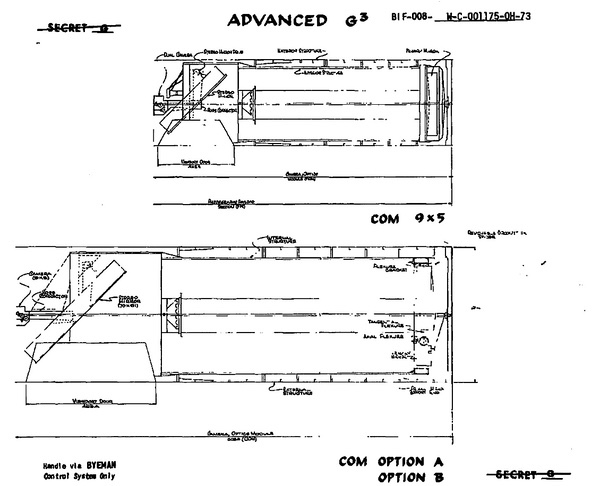 The Advanced GAMBIT-3 would have had an optical system substantially scaled-up from that of the GAMBIT-3 already in service. The mass of the mirrors was substantially decreased compared to earlier systems, demonstrating significant technology development in the early 1970s. (credit: NRO) |
The AG3 camera had a primary mirror with a diameter of 178 centimeters (70 inches), nearly the same as that of the DORIAN camera system on the MOL. The camera had a focal length of 711 centimeters (280 inches), compared with 445 centimeters (175 inches) for the GAMBIT-3. This mirror diameter was smaller than that of the Ultra High Resolution GAMBIT system that was discussed two years earlier, possibly to further reduce weight.
According to Horzempa, Advanced GAMBIT-3 would have used a very lightweight large mirror in its camera system, half the mass of the MOL/DORIAN system that was canceled only four years earlier. This represented a major reduction in mirror weight that may have made it possible to fly the spacecraft on a launch vehicle that was not as big as that required for the KENNEN, although it would still require an upgraded launch vehicle compared to the standard GAMBIT-3 (see “Advanced Gambit and VHR,” The Space Review, July 25, 2022).
GAMBIT in shuttle
Years: 1970s
Details: Limited details available
The GAMBIT program had its first launch in 1963 and its last in 1984. By the early 1970s, the program was scheduled for retirement by around 1980, but the launch rate was later reduced to stretch out the lifetime of the program without purchasing more than the planned 54 GAMBIT-3 vehicles. However, by the early 1970s there was apparently some discussion of adapting the GAMBIT camera system to fly in the space shuttle payload bay. No details of this are available. A single chart shows “GAMBIT-4” and “GAMBIT-5” vehicles possibly carried by the space shuttle throughout the 1980s.
A 1978 document refers to a study known as the “GAMBIT Shuttle Sortie Payload.” It stated:
The purpose of the GAMBIT Sortie Program is to develop the capability to palletize selected portions of the present GAMBIT Photographic Satellite Vehicle (PSV) for use on the Space Shuttle. The system would be capable of providing high resolution, color, and color infrared imagery from the shuttle cargo bay during orbital flight. This approach would allow multiple uses of a GAMBIT payload without having to expend hardware as would be required for a Titan launched payload. Further, the sustaining level of manpower required to support the palletized payload would be much lower than required to support the current program. Thus, the program would be continued, if necessary, beyond the mid-1980s at a lower level of funding than would be required to maintain the Titan launch capability for the backup system.
Another document refers to a GAMBIT transition design consisting of an uprated 228-centimeter (90-inch) system with dual shuttle and expendable launch vehicle capability, and an on-orbit operating life of six months. It also refers to a GAMBIT optimized for STS (block change design) with a one-year operating life. In 1977, new NRO Director Hans Mark also asked for information on the possibility of carrying a GAMBIT Dual Mode vehicle inside the shuttle’s payload bay. GAMBIT Dual Mode was a concept initiated in the early 1970s as HIGHERBOY (or HIGH BOY) and consisted of modifications made to a standard GAMBIT-3 spacecraft to enable it to operate in a higher orbit and provide wider area coverage, either as a backup to fill a gap in HEXAGON area coverage, or to operate high enough to avoid Soviet anti-satellite weapons. It was renamed Dual Mode by the later 1970s. Only one GAMBIT Dual Mode mission was launched, in 1982. No other details about why Mark asked for a proposal to carry it in the shuttle are available.
HEXAGON launched by shuttle
Years: 1973–1980
Details: Equivalent to HEXAGON capabilities
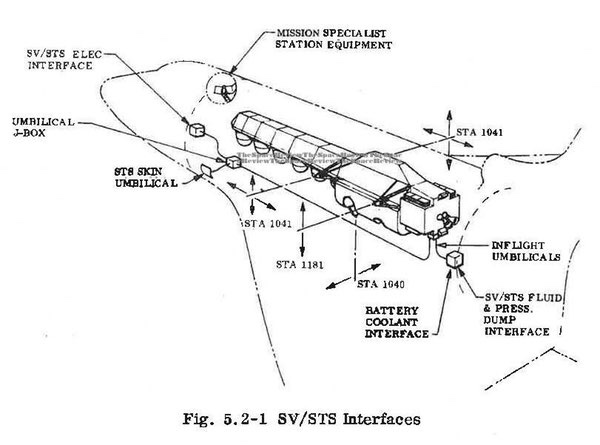 A HEXAGON specifically designed to take advantage of the shuttle could have added film and reentry vehicles. By the 1970s, HEXAGON was over-fulfilling the intelligence requirements. One possibility was a "HEXAGON-light" version that had lower resolution in order to add other capabilities like a longer lifetime. (credit: NRO) |
The HEXAGON area search satellite entered service in summer 1971. Designed as a replacement for the venerable CORONA reconnaissance satellite, it was a large and complex satellite capable of photographing vast amounts of territory of the Soviet Union during each mission. When the space shuttle design was selected, one of the military’s requirements was that the shuttle payload bay be long enough to hold a HEXAGON satellite.
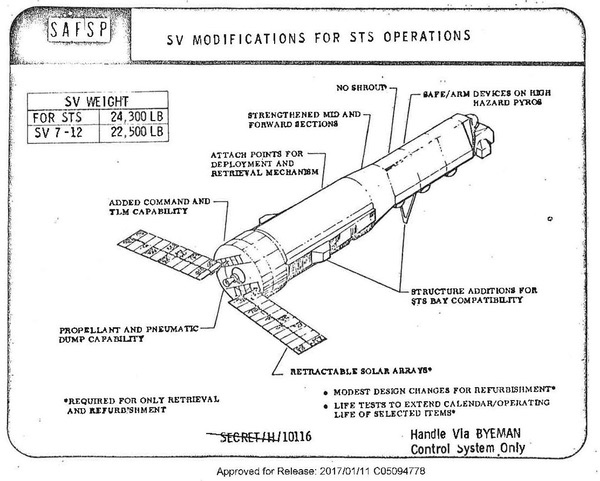 The most basic concept for putting the HEXAGON in the shuttle was making adaptations to the spacecraft necessary for shuttle launch, such as modifying the structure to handle the different launch loads. This was evaluated in the mid-1970s and rejected, apparently because the plan was to retire HEXAGON soon after the shuttle entered service. (credit: NRO) |
Because the shuttle offered many new opportunities for satellite refurbishing and reuse, the NRO began studying how its spacecraft could take advantage of the shuttle. In 1973, the NRO had its HEXAGON contractors undertake a study of adapting the HEXAGON to use the space shuttle. The contractors included Lockheed, which built the spacecraft; Perkin-Elmer, which built the camera system; and McDonnell Douglas, which built the Satellite Reentry Vehicles (SRV). The contractors evaluated multiple options. The most basic option was a minimal-modification HEXAGON that would have few changes from the version launched on the Titan-IIID, but would be adapted for the shuttle’s payload bay. This included internal strengthening and the addition of new mounting points along the sides of the spacecraft, as well as a tripod mounting between the second and third SRVs that connected to the bottom of the shuttle’s payload bay. Other modifications included adapting the HEXAGON’s communications system so that the shuttle crew could interact with it.
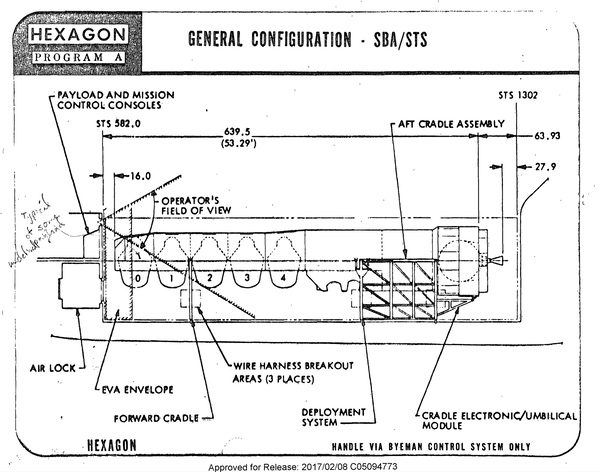 One proposal from the mid-1970s was to launch a modified HEXAGON area search satellite on the space shuttle. The existing HEXAGON had four reentry vehicles for carrying film, and could also be equipped with a mapping camera at the front that had its own reentry vehicle. A possible modification was to equip the HEXAGON with a fifth reentry vehicle. (credit: NRO) |
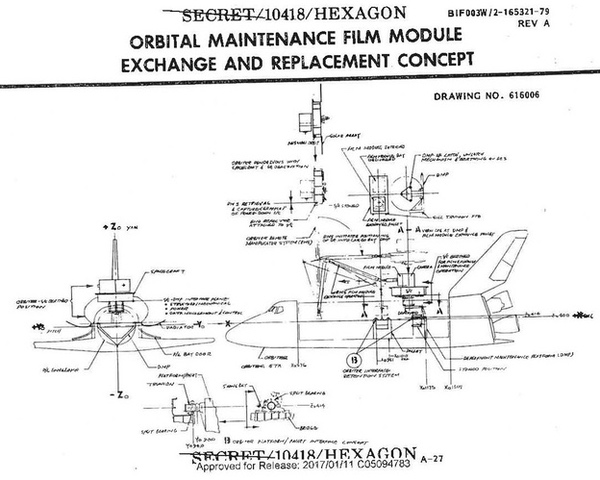 One of several concepts for launching and servicing a HEXAGON replacement satellite using the Space Shuttle. (credit: NRO) |
The contractors also looked at various iterations of the HEXAGON design, anywhere from four to up to ten Satellite Reentry Vehicles, and changes in the overall configuration of the spacecraft. These included moving the location of the film supply canisters and repositioning the cameras.
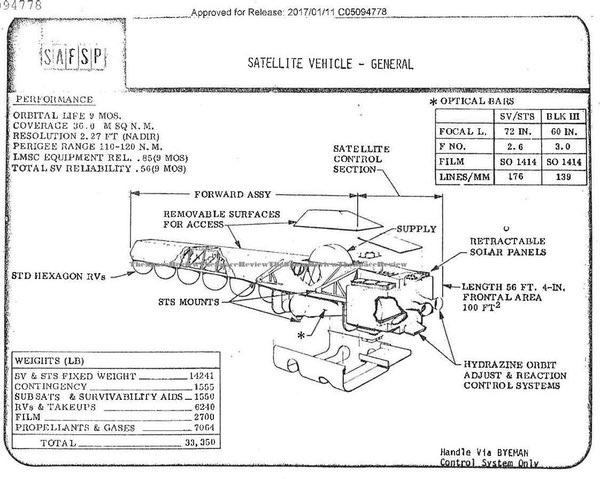 In the early 1970s a major study looked at options for redesigning the HEXAGON to use the space shuttle, One option would have completely redesigned the HEXAGON to take advantage of the larger payload bay compared to the Titan fairing. (credit: NRO) |
The most radical concept was for on-orbit servicing and resupply of the HEXAGON. HEXAGON would have been far more complex to service than the Hubble Space Telescope. Not only did it require refueling in orbit, it also required new film and new SRVs. The contractors proposed a servicing method whereby the HEXAGON would be secured horizontally above the shuttle’s payload bay, facing aft, with the propulsion section located near the shuttle’s crew compartment, and the HEXAGON’s forebody, where the Satellite Reentry Vehicles had been located, pointed toward the back of the payload bay. From that position, the entire forebody of the spacecraft would be rotated out of the way and down, and replaced with a new forebody containing loaded film supply canisters and new SRVs. At the same time, the rear end of the spacecraft, which contained the fuel supply and power system, would be serviced with a rotating tool kit that could provide replacement units. It would have been a highly complex procedure. The redesigned HEXAGON would require that the film supply be moved from behind the cameras to in front of them. What is unclear is how the new film would be re-threaded through the cameras and to the new SRVs in space. When the HEXAGON was manufactured, film was threaded through the camera system as it was built, not after it was complete. The film also was kept under tension through the film path, meaning that the film could not be cut before it was all used up in order to leave some in the camera. There was no way to thread film into an empty camera.
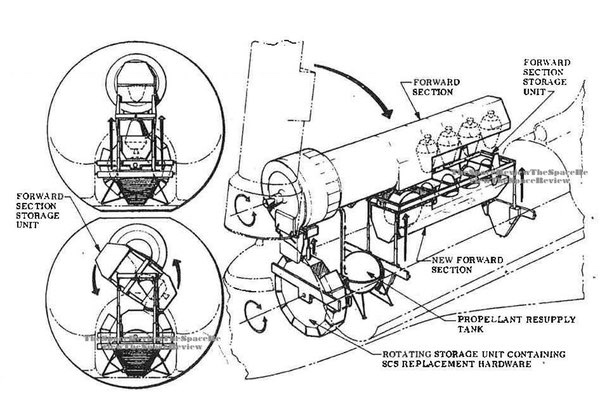 The early 1970s study of options for carrying HEXAGON in the shuttle included a full servicing option, with the shuttle being serviced in orbit. This would have required replacing fuel, film, and reentry vehicles, and would have been incredibly complex. (credit: NRO) |
 The most basic concept for putting the HEXAGON in the shuttle was making adaptations to the spacecraft necessary for shuttle launch, such as modifying the structure to handle the different launch loads. This was evaluated in the mid-1970s and rejected, apparently because the plan was to retire HEXAGON soon after the shuttle entered service. (credit: NRO) |
Because of the complexity of this resupply and refurbishment, the contractors recommended that the best course of action would be to use the shuttle to recover spent HEXAGON satellites in orbit and bring them back to Earth for refurbishment on the ground. The contractors also recommended that the NRO develop a shuttle-optimized HEXAGON, taking advantage of the greater width afforded by the shuttle’s payload bay compared to the diameter of the Titan-IIID. This optimized HEXAGON would have retractable solar arrays and a shorter and wider power and propulsion system at the rear. The film supply canisters, instead of being mounted between the camera system and the spacecraft’s propulsion section, would be moved forward and up above the cameras. These changes would have shortened the rear part of the spacecraft, enabling a longer forebody equipped with six SRVs instead of the four SRVs on the currently operational version. One intriguing proposal was for a Block III version, sort of a “HEXAGON-Light,” which would have had less-powerful cameras and slightly lower resolution, trading performance for other benefits. The NRO chose not to pursue the serviceable version.
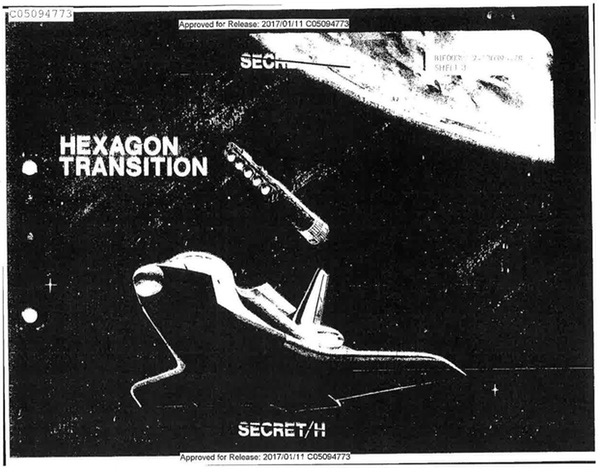 Low quality artwork of a HEXAGON satellite with five reentry vehicles being deployed from the space shuttle. Many at the National Reconnaissance Office were skeptical of the shuttle's capabilities. (credit: NRO) |
By 1975 NRO officials made several decisions. The first and most important was that they would not modify any of their spacecraft then in production such as HEXAGON to take advantage of the shuttle’s particular attributes. Around this time, a schematic showed a HEXAGON spacecraft in the shuttle payload bay and equipped with five reentry vehicles instead of the normal four. However, there is no indication that this concept was actively studied.
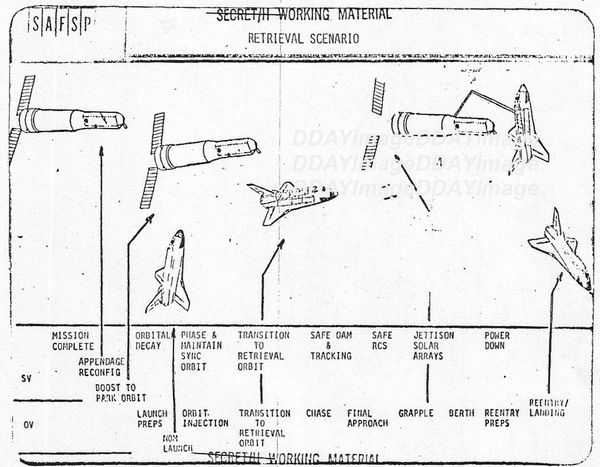 By the early 1980s, the HEXAGON program was scheduled for retirement. However, there were studies of retrieving one or more HEXAGON satellites at the end of their missions for reflight. The satellites would have been launched on Titan rockets, but brought back to Earth in a shuttle payload bay. The proposal was rejected for cost, schedule, and technical reasons. (credit: NRO) |
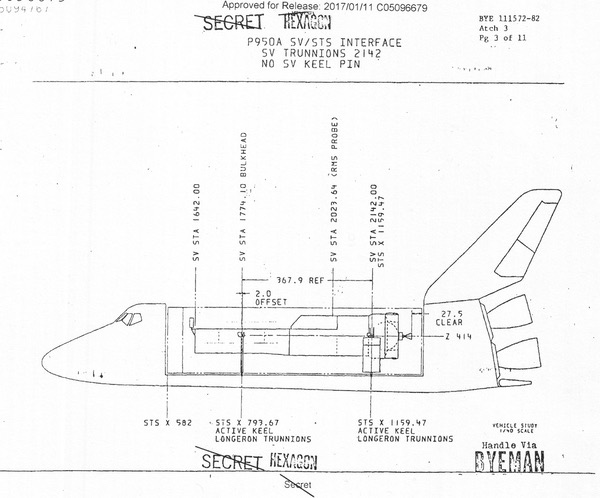 The early 1980s study of retrieving a HEXAGON satellite with the shuttle was possible because the shuttle's payload bay was originally sized to carry the satellite. (credit: NRO) |
In 1982, the NRO conducted a limited study concerning the possibility of retrieving one of the last HEXAGON satellites from polar orbit and returning it to the Earth inside the shuttle payload bay for refurbishment and later re-launch.
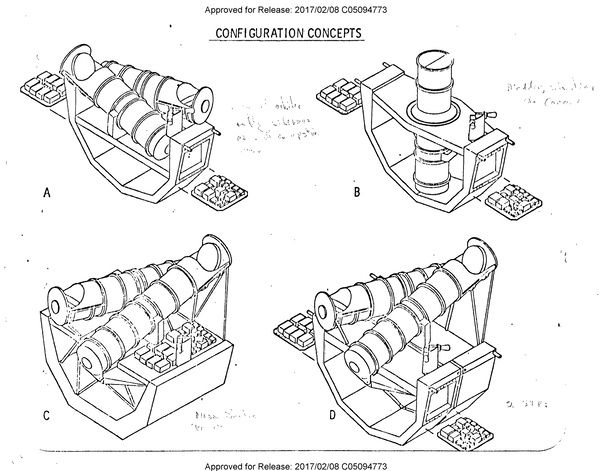 Under the Wide Area Search Payload (WASP) and the HEXAGON Area Search Pallet (HASP) studies, various companies studied ways of meeting the area search requirements then fulfilled by the HEXAGON satellite. One option was to mount optical systems inside the shuttle's payload bay. (credit: NRO) |
Panoramic Camera System/Single Camera Stereo
Years: 1978–1979
Focal length: equivalent to HEXAGON
Ground resolution: Equivalent to HEXAGON
By 1978, the NRO initiated several studies of using the shuttle as a platform to host reconnaissance cameras, rather than launch them into orbit. These included the Wide Area Search Payload (WASP) study and the HEXAGON Area Search Pallet (HASP) study. These studies overlapped and produced individual studies, making it difficult to understand them. It is possible that WASP was the overall program to study new camera and spacecraft systems to fulfill the area search requirement using the shuttle, whereas HASP was more focused on using HEXAGON-derived systems mounted in the payload bay. Ultimately, a system that used much HEXAGON hardware—which was most likely the cheapest and easiest option—was nearly built and flown in the early 1980s.
In December 1978 the NRO produced a mid-study briefing of a “Shuttle Transport System Panoramic Camera System Performance Analysis Study” also known as the PCS study. That study evaluated a HEXAGON camera system based upon the 17th HEXAGON vehicle—which had just started building and therefore represented the most recent version—mounted on a pallet in the shuttle’s payload bay. The HEXAGON camera system consisted of two cameras with 152-centimeter (60-inch) focal lengths and 51-centimeter (20-inch) apertures. The seventeenth satellite would carry 43,282 meters (142,000 feet) of film for each camera, with four takeup reels. It would also carry a new instrument, the HEXAGON Solid-State Stellar (S3, or “S-cubed”) sensor mounted in combination with the panoramic camera.
The final report was concluded by May 1979 and provided more detail on the Panoramic Camera System. The PCS would be 5.2 meters (17 feet) long, weigh 4,990 kilograms (11,000 pounds), and require two kilowatts of power for operation. PCS operation would be independent of the shuttle; it would be turned on and off and monitored from the Satellite Control Facility in Sunnyvale, California, where a large, blue-painted building near the freeway was popularly known as the “Blue Cube.”
While the PCS study was underway, another study project was started, known as the Shuttle Photographic Pallet Program (SPPP). It would have used existing flight qualified HEXAGON hardware mounted on a pallet inside the shuttle bay.
In spring 1978, the NRO had funded four camera contractors—Itek, Perkin-Elmer, Eastman-Kodak, and Fairchild—to study the use of a new single camera (in contrast to HEXAGON’s two cameras) to obtain stereo imagery for both wide area search and mapping, charting, and geodesy. The studies indicated that the concept was feasible using a Single Camera Stereo (SCS) payload with an aperture of approximately 51 centimeters (20 inches), the same as HEXAGON, although the focal length was apparently less than the HEXAGON’s 152 centimeters (60 inches). The camera concepts would use existing film but be capable of evolving to use a photo-conductive film for near-real time readout capability. Film was still the only method of storing the massive amounts of data generated by each sweep of the camera over a large amount of territory on the ground.
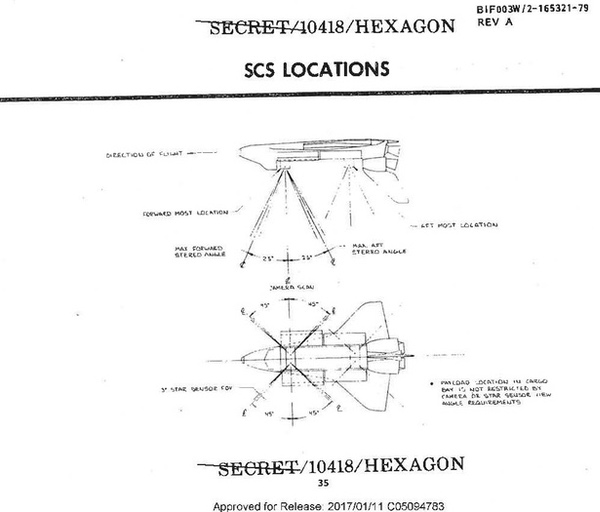 Late 1970s studies of carrying cameras in the shuttle payload bay evaluated the viewing angles for camera systems. Operating the shuttle in orbit for several weeks would have required substantial consumables to support the shuttle's systems. (credit: NRO) |
If launched from Vandenberg, the mission would last 15–20 days, but would require a dedicated shuttle flight. The Florida-launched mission would provide significant coverage of latitudes between 45 and 59 degrees, but not higher latitudes, whereas a Vandenberg launch would provide coverage above 57 degrees latitude, but provide 25–50% less coverage of the lower latitudes than the Florida-launched mission. The report concluded that the Vandenberg missions were not attractive from either a cost or ground coverage standpoint.
Although the pallet and SCS in the payload bay only weighed 2,268 kilograms (5,000 pounds), if the mission was to fly for 20 days this would require payload support equipment that weighed an additional 12,428 kilograms (27,400 pounds), more than a HEXAGON satellite. For an operational program the NRO would have to procure at least three full camera payloads, with two in ready condition for each launch. Camera refurbishment would take approximately 12 months. How often the cameras had to be refurbished was an important factor determining how many payloads would be required.
The study also addressed the possibility of an “interim free flyer” that would consist of three satellites launched from the payload bay to operate in slightly different orbits, using film in their cameras. Unlike HEXAGON, they would not use reentry vehicles to send the film to Earth, but would be retrieved by another shuttle approximately four months after launch.
By the late 1970s, the intelligence community’s search requirements were no longer as stringent as they had been when HEXAGON was first developed in the 1960s. The SCS camera would provide ground resolved distance of 0.8 meters (31.5 inches) at nadir, i.e., looking straight down from an orbit of 278–333 kilometers (150–180 nautical miles). This was significantly lower resolution than HEXAGON. The declassified capabilities of HEXAGON are listed as 0.6–0.9 meters (24–36 inches), but a simple calculation of the HEXAGON’s operational altitude and camera power indicates that under ideal situations the spacecraft could do substantially better than the publicly released figures. The imaging swath would be 160 kilometers cross-track, with stereo convergence of 20 to 55 degrees.
Eastman-Kodak proposed a camera using a Maksutov optical design which included a folded optical path that bent the image back inside the camera barrel, where other mirrors would focus the image. In contrast, Fairchild proposed a camera with a Petzval refracting design. The Fairchild camera used flat mirrors for bending the image into the camera, but the image focusing optics were refractive, with two sets of lenses to concentrate the image onto film that slid around the outside of the barrel containing the lenses.
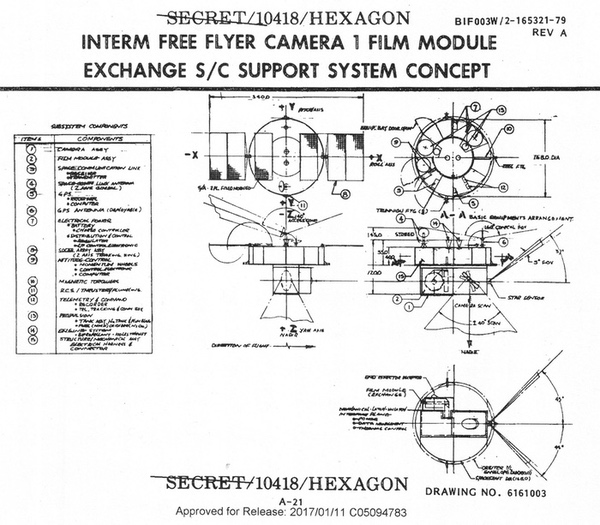 By the later 1970s, several companies were conducting studies of various replacements for the HEXAGON area search satellite. Options included smaller satellites that could be launched from the space shuttle and retrieved, or serviced, during a later mission. These systems would have used film, which was the only way to store the massive amount of data generated during their operation. (credit: NRO) |
The study also looked at free-flyer satellites using the two camera systems. The satellite would weigh approximately 3,765 kilograms (8,300 pounds), with 227 kilograms (500 pounds) of film and 680 kilograms (1,500 pounds) of propellant. Each spacecraft would be disc-shaped, with two deployable solar panels on top.
One possibility for the interim free-flyer approach was to conduct on-orbit servicing, replacing the film load and fuel for the satellites. The shuttle would rendezvous with a free-flyer satellite, grab it with the Remote Manipulator System (i.e. the Canadarm), and bring it into the payload bay. It would then be attached to the deployable maintenance platform (DMP) developed for the Hubble Space Telescope, or another maintenance platform that NASA was developing for early shuttle flights. Astronauts would perform spacewalks to replace the film, or the entire spacecraft could be returned to Earth. But the study indicated that capture, servicing and reflight were all relatively unknown options that could potentially be expensive. They would not really know until the shuttle started flying and demonstrating this capability. These studies ultimately led to a program known as DAMON.
DAMON
Year: 1980
Details: HEXAGON equivalent (although with less total film)
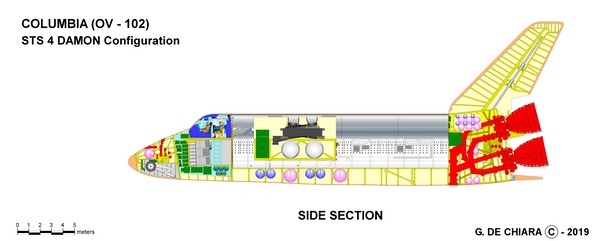 The DAMON system in the shuttle's payload bay. DAMON grew out of a program named ZEUS and was initially named ZEUS-PATHFINDER. (credit: Giuseppe De Chiara) |
In the early 1980s the NRO began a program to carry a top-secret reconnaissance camera in the shuttle payload bay. The program was named DAMON and had it flown, it would have launched aboard the shuttle Columbia in the second quarter of 1982, becoming the first military/intelligence payload ever scheduled to fly on the shuttle. DAMON may have received its name after the story of Damon and Pythias, which illustrated the ideal of friendship, and one of the purposes of the mission was to demonstrate that the NRO and NASA could cooperate on Space Shuttle missions.
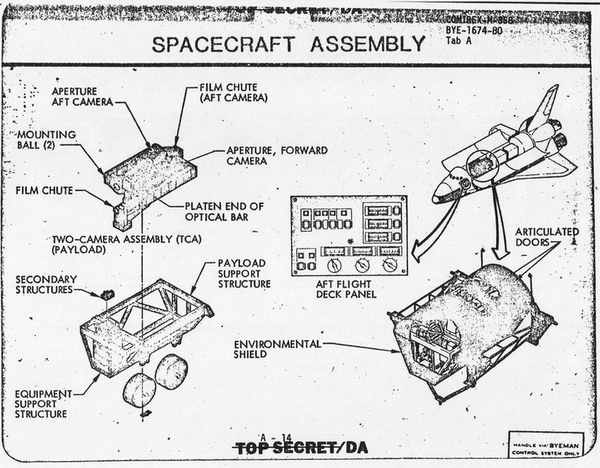 DAMON would have used systems derived from the HEXAGON satellite, and looks similar to the camera section of that large spacecraft. (credit: NRO) |
DAMON began as the ZEUS/PATHFINDER program, evolving out of the ZEUS program to place optical systems onboard NASA’s Space Shuttle, replacing the HEXAGON satellites that photographed vast swaths of the Soviet Union at medium resolution (see “Black ZEUS: The top secret shuttle mission that never flew,” The Space Review, January 30, 2017; “Black ops and the shuttle (part 2), Reconnaissance missions in the space shuttle, from WASP to ZEUS,” The Space Review, August 7, 2017; and “Top Secret DAMON: the classified reconnaissance payload planned for the fourth space shuttle mission,” The Space Review, July 1, 2019). By October 1979, ZEUS/PATHFINDER had progressed to the point where the NRO was ready to fly an initial payload. Various camera systems had been evaluated, but the NRO ultimately decided upon an inexpensive and conservative approach, using existing camera hardware from the HEXAGON reconnaissance satellite mounted on a pallet in the shuttle payload bay.
 The astronauts would have operated DAMON in orbit, although other concepts involved having the payload operated from the ground. (credit: NRO) |
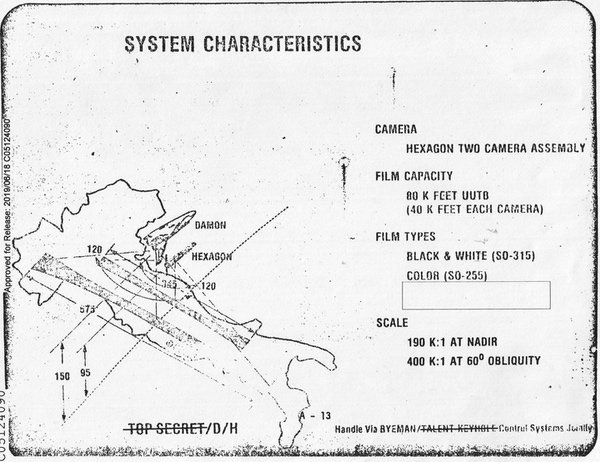 The shuttle carrying the DAMON payload would have flown in a higher orbit than the HEXAGON satellite and therefore photographed more area at lower resolution. The amount of territory it could photograph during a single mission was substantial. (credit: NRO) |
DAMON was approved by early 1980, with Lockheed selected as the prime contractor. Perkin-Elmer, which manufactured the HEXAGON camera, was to build the camera system. By spring, the program ran into congressional opposition. It was funded to the end of the year, but Congress refused to approve any further funds and the program was canceled.
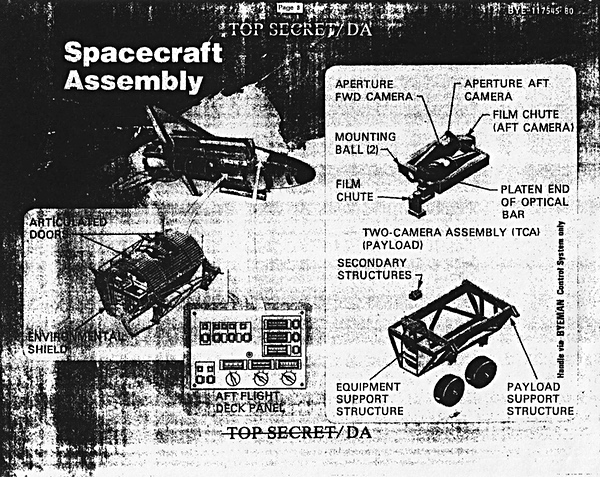 The operations concept for DAMON involved building three systems and maintaining them at the launch site. This would have turned the space shuttle into a manned reconnaissance system, like the SR-71 Blackbird or the U-2 Dragon Lady. (credit: NRO) |
DAMON would have launched into orbit from Cape Canaveral. Although it was intended for a 57-degree orbit, it may have had to fly in a lower-inclination orbit which would have limited its ability to photograph the Soviet Union.
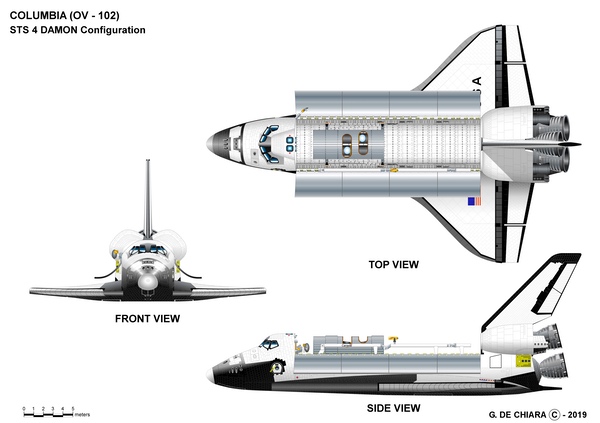 DAMON was a 1980 proposal to adapt a HEXAGON dual camera search system to fly in the shuttle's payload bay. The proposal was initially approved and began development before it was canceled. If approved, it would have flown on STS-4. (credit: Giuseppe De Chiara) |
Conclusion
The Samos E-4, SPARTAN, UPWARD, and DAMON proposals all resulted in at least some engineering and possibly even flight hardware. SPIN SCAN appears to have been seriously considered for development and was studied significantly more than most of the others. As a means of diversifying American reconnaissance assets and reducing vulnerability, it may have had some possibility of being approved, but as it became more capable, it also posed a political risk to the development of the KH-11 KENNEN, and therefore was less likely to be approved.
There were almost certainly other proposed photographic reconnaissance systems during the first two decades of the American intelligence space program. Once the KH-11 KENNEN entered service, there were probably also proposals for smaller satellites that used the same electro-optical imaging technology. Whether they were ever seriously considered remains unknown.
Note: we are using a new commenting system, which may require you to create a new account.
